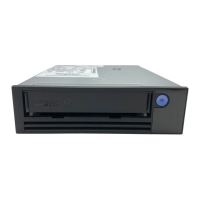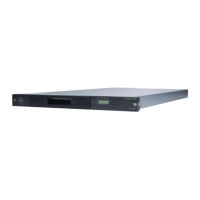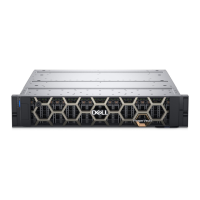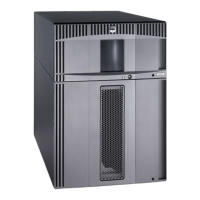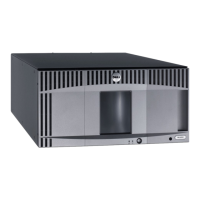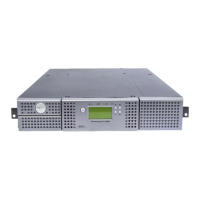



Do you have a question about the Dell PowerVault RD1000 and is the answer not in the manual?
Provides a general description of the Dell PowerVault RD1000 as a removable hard disk drive system.
Describes the types of Dell RD1000 cartridges supported by the hard drive system.
Explains that the RD1000 works with industry backup applications and where to find instructions.
Details the essential Windows software for the RD1000 unit, including its features.
States that no special software is necessary for running the RD1000 with Linux.
Describes the operation of the power indicator located on the eject button.
Explains the status indicators for the cartridge and their meanings.
Details the conditions and procedures for entering and exiting Low Power Mode for the external USB drive.
Outlines software installation for Dell-installed internal RD1000 drives.
Guides users on installing the internal RD1000 drive when it is not pre-installed by Dell.
Provides prerequisites and information before starting the internal drive installation.
Lists essential safety guidelines to prevent electro-static damage during installation.
Provides step-by-step instructions for installing the RD1000 internal SATA drive.
Explains compatibility and performance considerations for USB 2.0 and USB 3.0 cables with the external drive.
Describes typical activities involved in operating and maintaining the RD1000 unit.
Offers best practices and precautions for handling RD1000 cartridges to ensure data integrity.
Step-by-step guide on how to properly insert a cartridge into the RD1000 drive.
Instructions for removing a cartridge using software or the eject button.
Describes the emergency procedure to eject a cartridge using a paper clip.
Explains how to copy files to the RD1000 cartridge using Windows Explorer.
Introduces the RD1000 Utility as a Windows application for diagnosing and managing the device.
Guides on how to launch and use the RD1000 Utility for diagnostics and status checks.
Details troubleshooting steps when the power indicator is off for internal and external drives.
Explains issues and solutions when the power indicator shows a steady amber light.
Addresses blinking amber power indicator and failure to eject the cartridge.
Details troubleshooting for a steady amber cartridge indicator, indicating cartridge issues.
Provides steps for when the cartridge fails to eject, including emergency methods.
Guides on how to make the unit appear in Windows Device Manager.
Discusses slow performance issues for both internal and external RD1000 drives.
Explains potential performance reductions for Linux users and file system recommendations.
Provides solutions for backup application write errors.
Addresses firmware download failures specific to Windows Server 2003.
Explains issues with ejecting cartridges on Windows 2000.
Details slow performance for external drives on Windows 2000 due to USB drivers.
Covers problems with the system boot process when the external RD1000 is attached.
Provides general manufacturer and interface type information for the RD1000.
Lists transfer rates, access time, block size, and supported file systems for the RD1000.
States the unrecoverable error rate and Mean Time Between Failures (MTBF) for the RD1000.
Details physical dimensions and weight for internal, external, and media components.
Outlines voltage tolerance, power consumption, and AC adapter specifications.
Lists operational and non-operational temperature, humidity, altitude, and shock specifications.
Introduces the use of RD1000 removable disk drives on Linux operating systems.
Lists Linux distributions tested and found compliant with RD1000 devices.
Discusses file system choices like FAT32, ext2, ext3 for Linux and their impact on performance.
Explains how to make cartridges accessible by backup applications in Linux.
Details how to properly un-mount and eject a mounted cartridge in Linux.
Describes using the 'tar' command for backups on RD1000 drives, including spanning cartridges.
Provides a command to check if the RD1000 drive is recognized by the Linux system.
Offers troubleshooting steps for failures in the e2fsck file system check on ext2/ext3 cartridges.
Provides a general description of the Dell PowerVault RD1000 as a removable hard disk drive system.
Describes the types of Dell RD1000 cartridges supported by the hard drive system.
Explains that the RD1000 works with industry backup applications and where to find instructions.
Details the essential Windows software for the RD1000 unit, including its features.
States that no special software is necessary for running the RD1000 with Linux.
Describes the operation of the power indicator located on the eject button.
Explains the status indicators for the cartridge and their meanings.
Details the conditions and procedures for entering and exiting Low Power Mode for the external USB drive.
Outlines software installation for Dell-installed internal RD1000 drives.
Guides users on installing the internal RD1000 drive when it is not pre-installed by Dell.
Provides prerequisites and information before starting the internal drive installation.
Lists essential safety guidelines to prevent electro-static damage during installation.
Provides step-by-step instructions for installing the RD1000 internal SATA drive.
Explains compatibility and performance considerations for USB 2.0 and USB 3.0 cables with the external drive.
Describes typical activities involved in operating and maintaining the RD1000 unit.
Offers best practices and precautions for handling RD1000 cartridges to ensure data integrity.
Step-by-step guide on how to properly insert a cartridge into the RD1000 drive.
Instructions for removing a cartridge using software or the eject button.
Describes the emergency procedure to eject a cartridge using a paper clip.
Explains how to copy files to the RD1000 cartridge using Windows Explorer.
Introduces the RD1000 Utility as a Windows application for diagnosing and managing the device.
Guides on how to launch and use the RD1000 Utility for diagnostics and status checks.
Details troubleshooting steps when the power indicator is off for internal and external drives.
Explains issues and solutions when the power indicator shows a steady amber light.
Addresses blinking amber power indicator and failure to eject the cartridge.
Details troubleshooting for a steady amber cartridge indicator, indicating cartridge issues.
Provides steps for when the cartridge fails to eject, including emergency methods.
Guides on how to make the unit appear in Windows Device Manager.
Discusses slow performance issues for both internal and external RD1000 drives.
Explains potential performance reductions for Linux users and file system recommendations.
Provides solutions for backup application write errors.
Addresses firmware download failures specific to Windows Server 2003.
Explains issues with ejecting cartridges on Windows 2000.
Details slow performance for external drives on Windows 2000 due to USB drivers.
Covers problems with the system boot process when the external RD1000 is attached.
Provides general manufacturer and interface type information for the RD1000.
Lists transfer rates, access time, block size, and supported file systems for the RD1000.
States the unrecoverable error rate and Mean Time Between Failures (MTBF) for the RD1000.
Details physical dimensions and weight for internal, external, and media components.
Outlines voltage tolerance, power consumption, and AC adapter specifications.
Lists operational and non-operational temperature, humidity, altitude, and shock specifications.
Introduces the use of RD1000 removable disk drives on Linux operating systems.
Lists Linux distributions tested and found compliant with RD1000 devices.
Discusses file system choices like FAT32, ext2, ext3 for Linux and their impact on performance.
Explains how to make cartridges accessible by backup applications in Linux.
Details how to properly un-mount and eject a mounted cartridge in Linux.
Describes using the 'tar' command for backups on RD1000 drives, including spanning cartridges.
Provides a command to check if the RD1000 drive is recognized by the Linux system.
Offers troubleshooting steps for failures in the e2fsck file system check on ext2/ext3 cartridges.
| Category | Storage |
|---|---|
| Type | External |
| Interface | USB 2.0 |
| Form Factor | Desktop |
| Data Transfer Rate | Up to 480 Mbps |
| Compatibility | Windows |
| Cartridge Type | RD1000 |

